Guozhong Cao. Nanostructures & Nanomaterials: Synthesis, Properties & Applications
Подождите немного. Документ загружается.

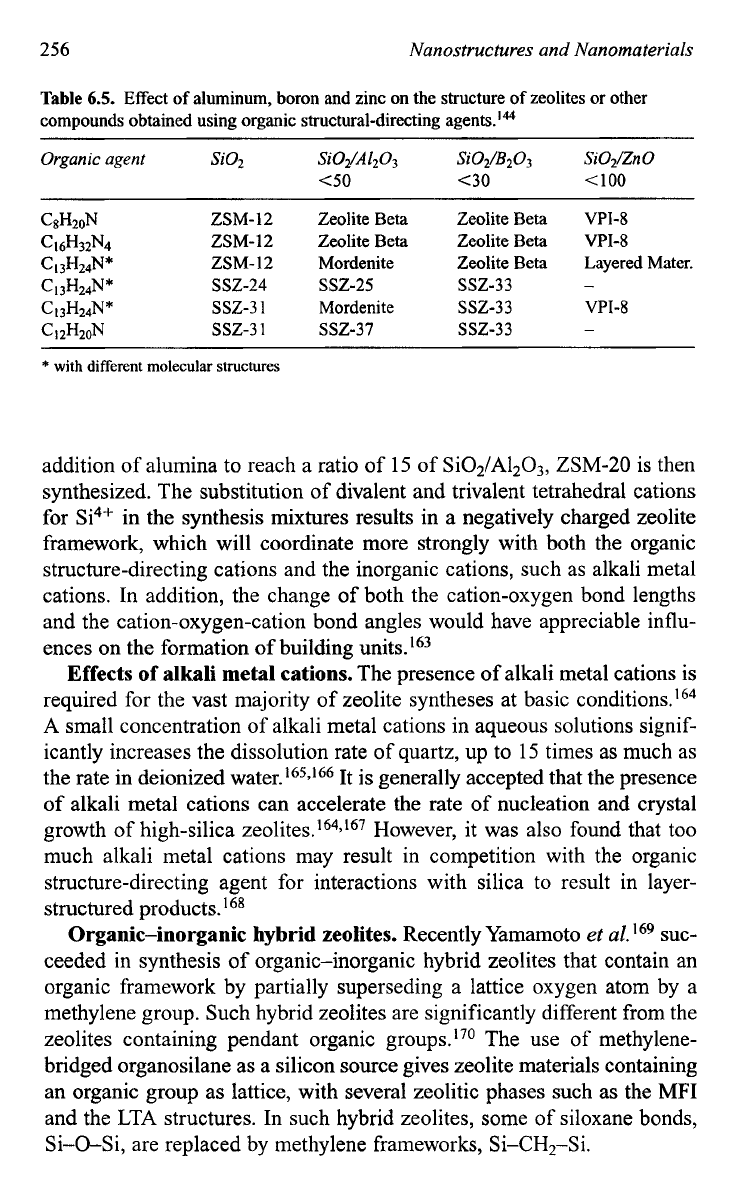
256
Nanostructures and Nanomaterials
Table
6.5.
Effect
of
aluminum, boron and zinc on the structure
of
zeolites or other
compounds obtained using organic structural-directing agents.'*
Organic
agent
SO2
Si02/A120s
C50
C8H20N
ZSM-12 Zeolite Beta
C16H32N4
ZSM-12 Zeolite Beta
c
I3H24N*
ZSM-I2
Mordenite
Cl3H24N*
ssz-3
1
Mordenite
c
I
3H24N*
ssz-24 ssz-25
CIZH20N
ssz-3
1
ssz-37
Si02/B203
<30
Zeolite Beta
Zeolite Beta
Zeolite Beta
ssz-33
ssz-33
ssz-33
SiOZ/Zn
0
<I00
VPI-8
VPI-8
Layered Mater.
VPI-8
-
~~ ~ ~~
*
with different molecular structures
addition of alumina to reach a ratio of
15
of Si02/A1203,
ZSM-20
is then
synthesized. The substitution
of
divalent and trivalent tetrahedral cations
for Si4+ in the synthesis mixtures results in a negatively charged zeolite
framework, which will coordinate more strongly with both the organic
structure-directing cations and the inorganic cations, such as alkali metal
cations. In addition, the change of both the cation-oxygen bond lengths
and the cation-oxygen-cation bond angles would have appreciable influ-
ences on the formation of building units.163
Effects
of
alkali metal cations.
The presence
of
alkali metal cations is
required for the vast majority of zeolite syntheses at basic
condition^.'^^
A small concentration
of
alkali metal cations in aqueous solutions signif-
icantly increases the dissolution rate of quartz, up to
15
times as much as
the rate in deionized ~ater.'~~,'~~ It
is
generally accepted that the presence
of
alkali metal cations can accelerate the rate of nucleation and crystal
growth of high-silica
zeolite^.'^^^'^^
However, it was also found that too
much alkali metal cations may result in competition with the organic
structure-directing agent for interactions with silica
to
result in layer-
structured products.'68
Organic-inorganic hybrid zeolites.
Recently Yamamoto
et
al.
69
suc-
ceeded in synthesis of organic-inorganic hybrid zeolites that contain an
organic framework by partially superseding a lattice oxygen atom by a
methylene group. Such hybrid zeolites are significantly different from the
zeolites containing pendant organic groups.'70 The use of methylene-
bridged organosilane as a silicon source gives zeolite materials containing
an organic group as lattice, with several zeolitic phases such as the MFI
and the LTA structures. In such hybrid zeolites, some of siloxane bonds,
Si-0-25, are replaced by methylene frameworks, Si-CH,-Si.
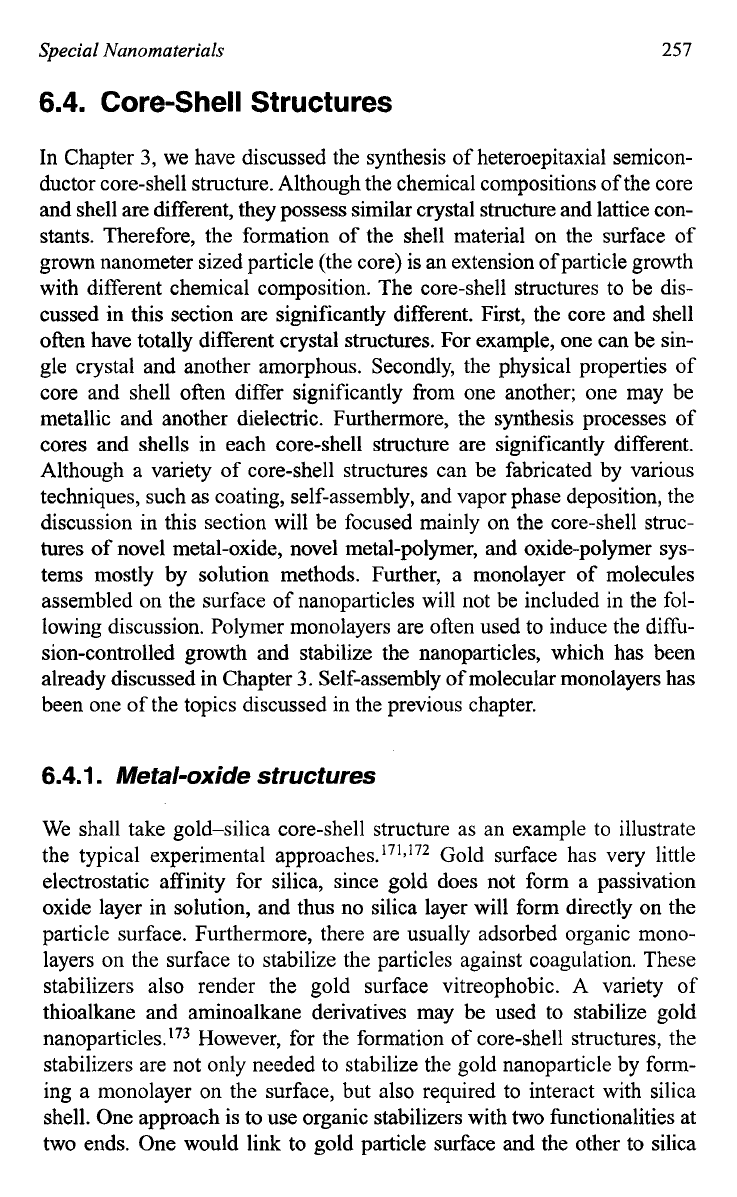
Special Nanomaterials
257
6.4.
Core-Shell Structures
In Chapter
3,
we have discussed the synthesis of heteroepitaxial semicon-
ductor core-shell structure. Although the chemical compositions of the core
and shell are different, they possess similar crystal structure and lattice con-
stants. Therefore, the formation of the shell material on the surface
of
grown nanometer sized particle (the core) is an extension of particle growth
with different chemical composition. The core-shell structures to be dis-
cussed in this section are significantly different. First, the core and shell
often have totally different crystal structures. For example, one can be sin-
gle crystal and another amorphous. Secondly, the physical properties of
core and shell often differ significantly from one another; one may be
metallic and another dielectric. Furthermore, the synthesis processes of
cores and shells in each core-shell structure are significantly different.
Although a variety of core-shell structures can be fabricated by various
techniques, such as coating, self-assembly, and vapor phase deposition, the
discussion in this section will be focused mainly on the core-shell struc-
tures of novel metal-oxide, novel metal-polymer, and oxide-polymer
sys-
tems mostly by solution methods. Further, a monolayer of molecules
assembled on the surface of nanoparticles will not be included in the fol-
lowing discussion. Polymer monolayers are often used to induce the difi-
sion-controlled growth and stabilize the nanoparticles, which has been
already discussed in Chapter
3. Self-assembly of molecular monolayers has
been one of the topics discussed in the previous chapter.
6.4.1.
Metal-oxide structures
We shall take gold-silica core-shell structure
as
an example to illustrate
the typical experimental approaches.
1719172
Gold surface has very little
electrostatic affinity for silica, since gold does not form a passivation
oxide layer in solution, and thus no silica layer will form directly on the
particle surface. Furthermore, there are usually adsorbed organic mono-
layers on the surface to stabilize the particles against coagulation. These
stabilizers also render the gold surface vitreophobic.
A
variety of
thioalkane and aminoalkane derivatives may be used to stabilize gold
nan~particles.'~~ However, for the formation of core-shell structures, the
stabilizers are not only needed to stabilize the gold nanoparticle by form-
ing a monolayer on the surface, but also required to interact with silica
shell. One approach is to use organic stabilizers with two fhctionalities at
two ends. One would link to gold particle surface and the other to silica
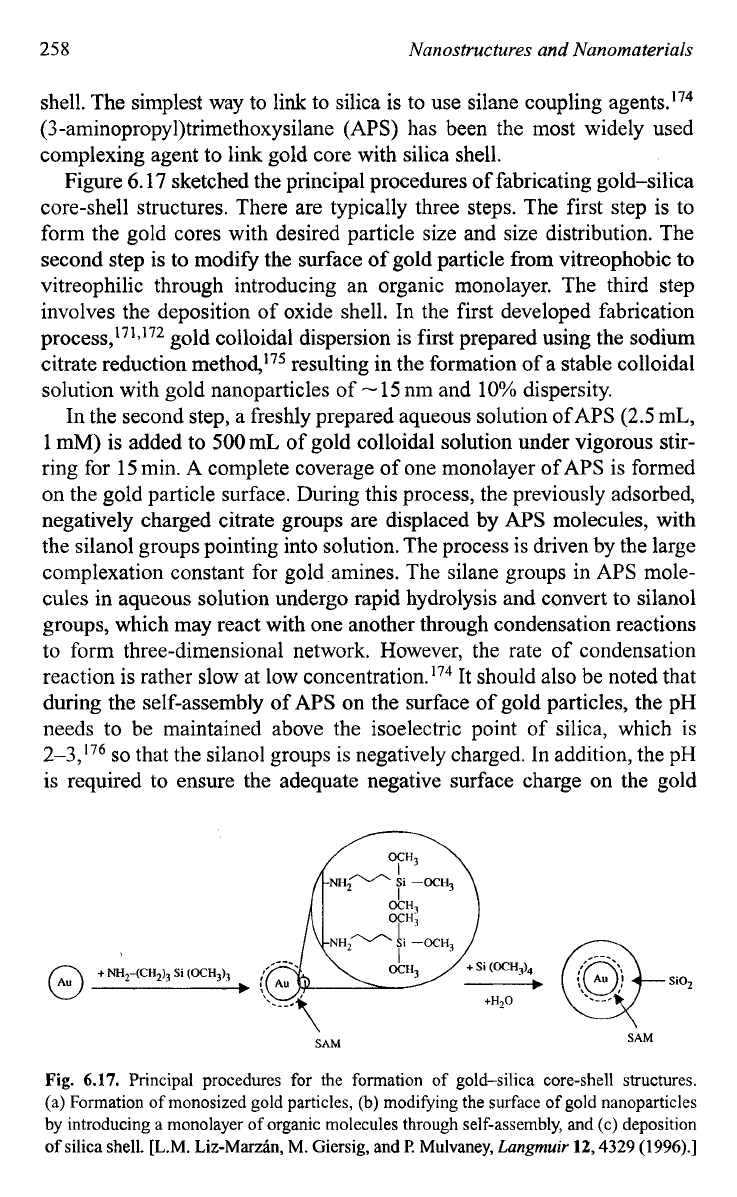
258
Nunostructures and Nunornaterials
shell. The simplest way to link to silica is to use silane coupling agents.'74
(3-aminopropyl)trimethoxysilane
(APS) has been the most widely used
complexing agent to link gold core with silica shell.
Figure 6.17 sketched the principal procedures of fabricating gold-silica
core-shell structures. There are typically three steps. The first step is to
form the gold cores with desired particle size and size distribution. The
second step is to modify the surface of gold particle from vitreophobic to
vitreophilic through introducing an organic monolayer. The third step
involves the deposition of oxide shell. In the first developed fabrication
pro~ess,~~*~'~~ gold colloidal dispersion is first prepared using the sodium
citrate reduction method,175 resulting in the formation of a stable colloidal
solution with gold nanoparticles of
-
15 nm and 10% dispersity.
In the second step, a freshly prepared aqueous solution ofAPS
(2.5
mL,
1
mM)
is added to 500mL of gold colloidal solution under vigorous stir-
ring for 15 min.
A
complete coverage of one monolayer of
APS
is formed
on the gold particle surface. During this process, the previously adsorbed,
negatively charged citrate groups are displaced by
APS
molecules, with
the silanol groups pointing into solution. The process is driven by the large
complexation constant for gold amines. The silane groups in APS mole-
cules in aqueous solution undergo rapid hydrolysis and convert to silanol
groups, which may react with one another through condensation reactions
to form three-dimensional network. However, the rate of condensation
reaction is rather slow at low c~ncentration.'~~ It should also be noted that
during the self-assembly of
APS
on the surface
of
gold particles, the pH
needs to be maintained above the isoelectric point of silica, which is
2-3,'76
so
that the silanol groups is negatively charged. In addition, the pH
is required to ensure the adequate negative surface charge on the gold
Fig.
6.17.
Principal procedures for the formation of gold-silica core-shell structures.
(a) Formation of monosized gold particles,
(b)
modifying the surface
of
gold nanoparticles
by introducing a monolayer of organic molecules through self-assembly, and (c) deposition
of silica shell. [L.M. Liz-Marzin, M. Giersig, and
I?
Mulvaney,
Lungmuir
12,4329
(1996).]
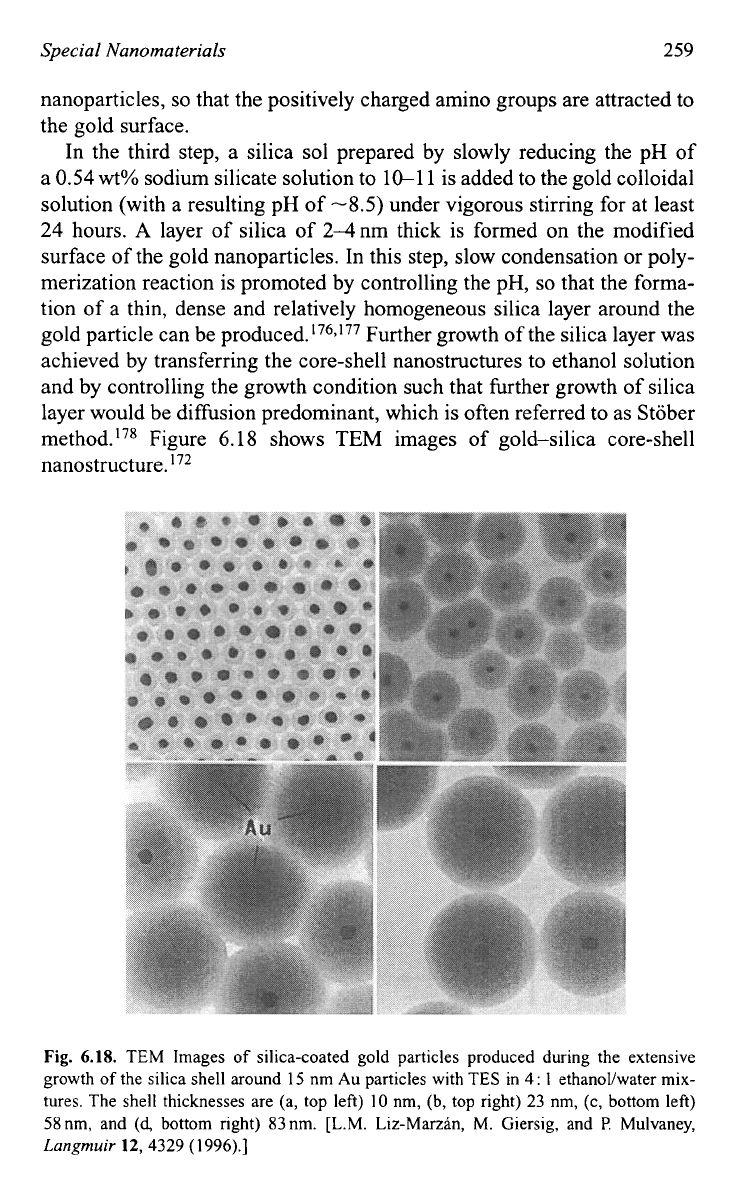
Special Nanomaterials
259
nanoparticles,
so
that the positively charged amino groups are attracted to
the gold surface.
In the third step, a silica sol prepared by slowly reducing the pH of
a
0.54wt%
sodium silicate solution to 161 1 is added to the gold colloidal
solution (with a resulting pH of
-8.5)
under vigorous stirring for at least
24
hours.
A
layer of silica of 2-4nm thick is formed on the modified
surface of the gold nanoparticles. In this step, slow condensation or poly-
merization reaction is promoted by controlling the pH,
so
that the forma-
tion of a thin, dense and relatively homogeneous silica layer around the
gold particle can be pr~duced.'~~,'~~ Further growth of the silica layer was
achieved by transferring the core-shell nanostructures to ethanol solution
and by controlling the growth condition such that further growth of silica
layer would be diffusion predominant, which is often referred to as Stober
method.'78 Figure 6.18 shows
TEM
images
of
gold-silica core-shell
nanostructure.
72
Fig.
6.18.
TEM Images of silica-coated gold particles produced during the extensive
growth of the silica shell around
15
nm Au particles with TES in
4
:
1
ethanol/water mix-
tures. The shell thicknesses are (a, top left)
10
nm, (b, top right)
23
nm,
(c,
bottom left)
58nm, and
(4
bottom right) 83nm. [L.M. Liz-Marzan,
M.
Giersig, and
P.
Mulvaney,
Langmuir
12,4329
(1
996).]
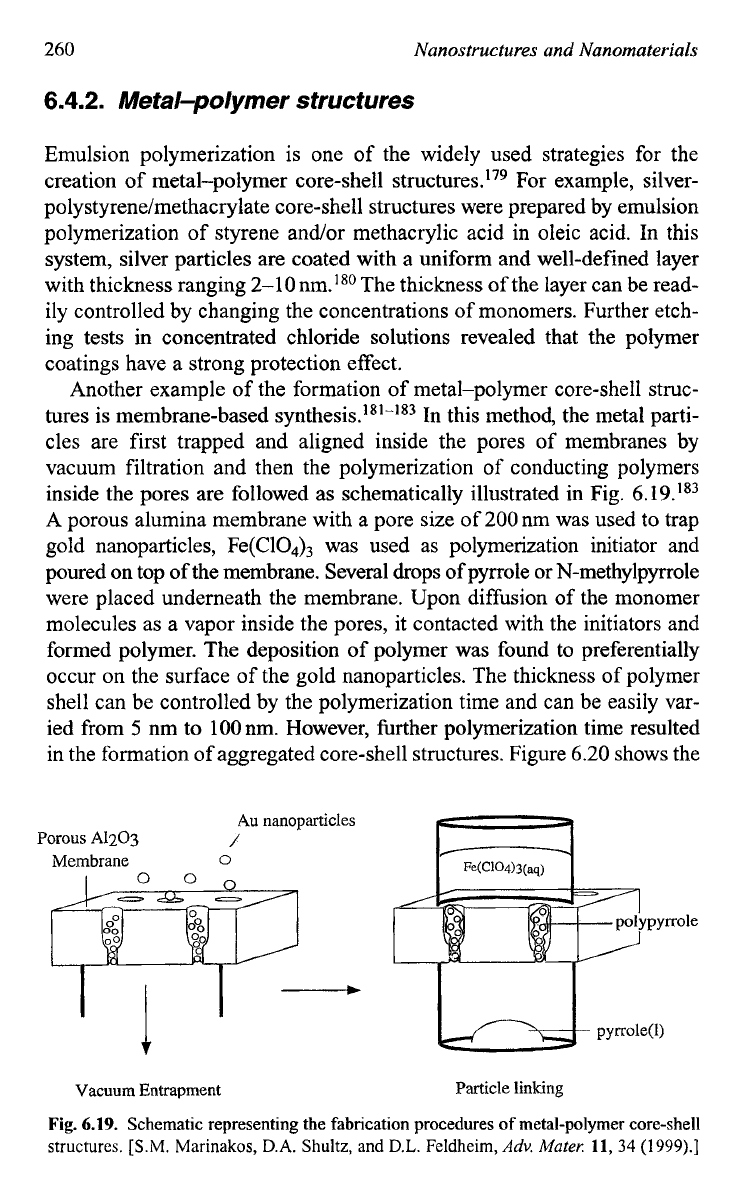
260
Nanostructures and Nanomaterials
6.4.2.
Metalkpolymer structures
Emulsion polymerization is one of the widely used strategies for the
creation of metal-polymer core-shell str~ctures.”~ For example, silver-
polystyrene/methacrylate
core-shell structures were prepared by emulsion
polymerization of styrene and/or methacrylic acid in oleic acid. In this
system, silver particles are coated with a uniform and well-defined layer
with thickness ranging
2-10
The thickness of the layer can be read-
ily controlled by changing the concentrations of monomers. Further etch-
ing tests in concentrated chloride solutions revealed that the polymer
coatings have a strong protection effect.
Another example of the formation of metal-polymer core-shell struc-
tures is membrane-based In this method, the metal parti-
cles are first trapped and aligned inside the pores of membranes by
vacuum filtration and then the polymerization of conducting polymers
inside the pores are followed as schematically illustrated in Fig.
6.19.’83
A porous alumina membrane with a pore size of
200
nm was used to trap
gold nanoparticles, Fe(C104)3 was used as polymerization initiator and
poured on top of the membrane. Several drops of pyrrole or N-methylpyrrole
were placed underneath the membrane. Upon diffusion of the monomer
molecules as a vapor inside the pores, it contacted with the initiators and
formed polymer. The deposition
of
polymer was found to preferentially
occur on the surface of the gold nanoparticles. The thickness of polymer
shell can be controlled by the polymerization time and can be easily var-
ied from
5
nm to 1OOnm. However, further polymerization time resulted
in the formation of aggregated core-shell structures. Figure
6.20
shows
the
Au
nanoparticles
Porous
A1203
/
Membrane
0
t
Vacuum Entrapment Particle linking
Fig.
6.19.
Schematic representing the fabrication procedures
of
metal-polymer core-shell
structures.
[S.M.
Marinakos,
D.A.
Shultz, and
D.L.
Feldheim,
Adv.
Muter:
11,
34
(1999).]
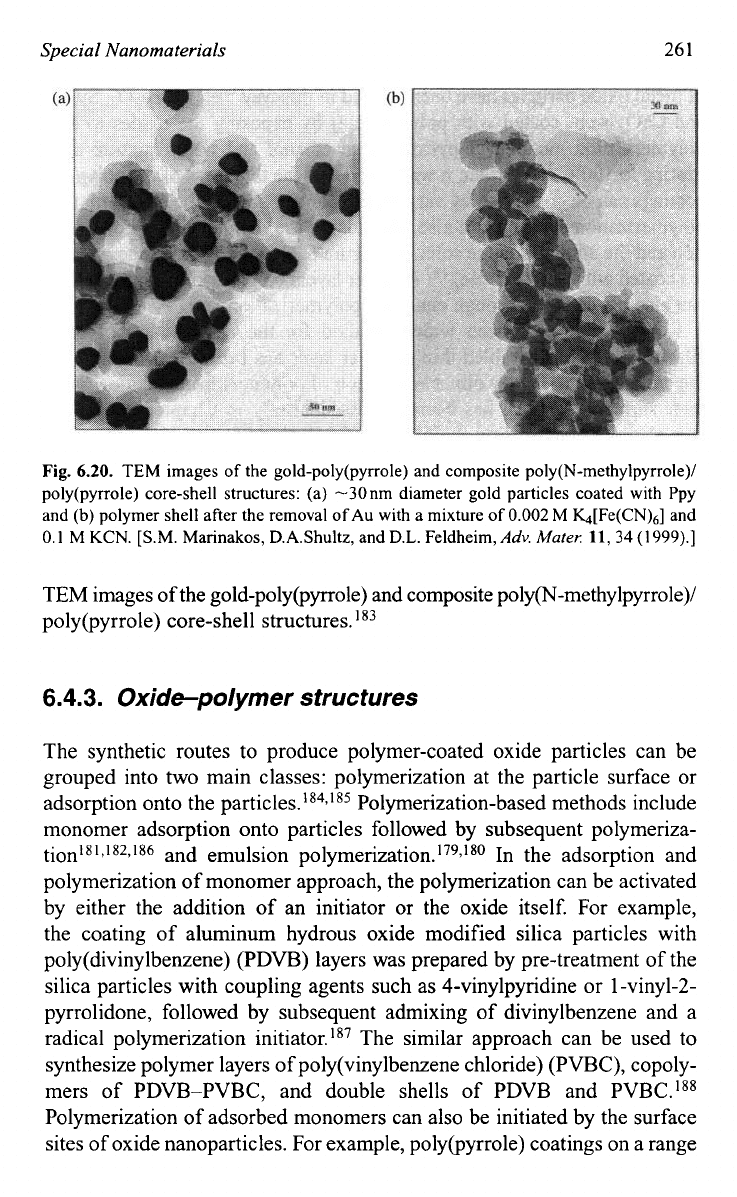
Special
Nanomaterials
26
1
Fig.
6.20.
TEM
images
of
the gold-poly(pyrro1e) and composite poly(N-methylpyrrole)/
poly(pyrro1e) core-shell structures:
(a)
-30
nm
diameter gold particles coated with Ppy
and
(b)
polymer shell after the removal
of
Au with a mixture
of
0.002
M
h[Fe(CN),] and
0.1
M
KCN.
[S.M.
Marinakos, D.A.Shultz, and D.L. Feldheim,
Adv.
Muter:
11,34
(1999).]
TEM images of the gold-poly(pyrro1e) and composite polyp-methylpyrrole)/
poly(pyrro1e) core-shell structures.
183
6.4.3.
Oxide-polymer structures
The synthetic routes to produce polymer-coated oxide particles can be
grouped into
two
main classes: polymerization at the particle surface or
adsorption onto the particles.
1847185
Polymerization-based methods include
monomer adsorption onto particles followed by subsequent polymeriza-
tion181,182,186 and emulsion polymeri~ation.'~~,'~~ In the adsorption and
polymerization
of
monomer approach, the polymerization can be activated
by either the addition of an initiator
or
the oxide itself. For example,
the coating of aluminum hydrous oxide modified silica particles with
poly(diviny1benzene) (PDVB) layers was prepared by pre-treatment of the
silica particles with coupling agents such as 4-vinylpyridine or
1
-vinyl-2-
pyrrolidone, followed by subsequent admixing of divinylbenzene and a
radical polymerization ir1itiat0r.I~~ The similar approach can be used to
synthesize polymer layers
of
poly(viny1benzene chloride) (PVBC), copoly-
mers
of
PDVB-PVBC, and double shells of PDVB and PVBC.I8*
Polymerization of adsorbed monomers can also be initiated by the surface
sites of oxide nanoparticles. For example, poly@yrrole) coatings on a range
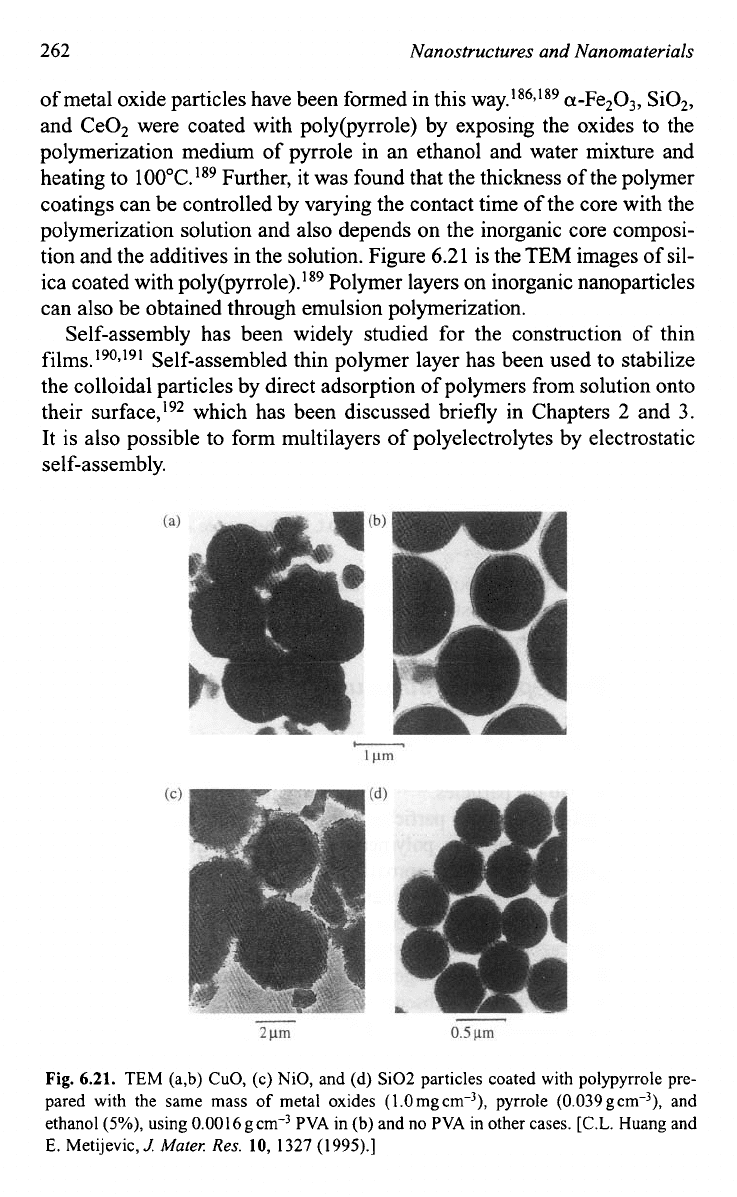
262
Nanostructures and Nanomaterials
of metal oxide particles have been formed in this way.186*'89 a-Fe2O,, SO2,
and Ce02 were coated with poly(pyrro1e) by exposing the oxides to the
polymerization medium of pyrrole in an ethanol and water mixture and
heating to 100°C.189 Further, it was found that the thickness of the polymer
coatings can be controlled by varying the contact time of the core with the
polymerization solution and also depends on the inorganic core composi-
tion and the additives in the solution. Figure 6.2 1 is the
TEM
images of sil-
ica coated with p~ly(pyrrole).'~~ Polymer layers on inorganic nanoparticles
can also be obtained through emulsion polymerization.
Self-assembly has been widely studied for the construction of thin
film^.'^^,'^^
Self-assembled thin polymer layer has been used to stabilize
the colloidal particles by direct adsorption of polymers from solution onto
their surface,192 which has been discussed briefly in Chapters
2
and
3.
It is also possible to form multilayers of polyelectrolytes by electrostatic
self-assembly.
Fig.
6.21.
TEM (a,b) CuO, (c) NiO, and (d) Si02 particles coated with polypyrrole pre-
pared with the same mass
of
metal oxides (l.Omg~rn-~), pyrrole (0.039gcrn-)), and
ethanol
(So/,),
using 0.0016g~m"~ PVA in (b) and no PVA in other cases. [C.L. Huang and
E. Metijevic,
J:
Muter:
Res.
10,
1327
(1995).]

Special Nanomaterials
263
6.5.
0
rg
an
i
c-l
no
rg
a n
ic
Hybrids
Organic-inorganic hybrids are materials in which organic and inorganic
components interpenetrate each other in nanometer scale and both form
percolated three-dimensional networks commonly by sol-gel processing.
Such organic-inorganic hybrids have also been termed Ormosils (organi-
cally modified silicates) or Ormocers (organically modified ceramics) in
literature. Hybrids are generally divided into two classes: (i) hybrids that
consist of organic molecules, oligomers or low molecular weight polymers
embedded in an inorganic matrix to which they are held by weak hydrogen
bonds or van der Waals forces, and (ii) hybrids in that the organic and inor-
ganic components are linked to each other through covalent bonds. Class
I
hybrids can be considered as molecular scale nanocomposites where
organic components are physically trapped in an inorganic matrix; whereas
class I1 hybrids can be considered as a huge molecule that links organic and
inorganic components through true chemical bonds.
6.5.1.
Class I
hybrids
There are a few routes developed for the synthesis of class I hybrids,
including hydrolysis and condensation of alkoxides inside soluble organic
polymers, mixing alkoxides and organic compounds in a common solvent,
and impregnating a porous oxide gel with organic compounds. All three
techniques have been widely explored for the formation of various
organic-inorganic hybrids. For example, hybrids comprising organic dyes
embedded in inorganic matrix, such as silica, aluminosilicate and transi-
tion metal
oxide^,'^^,'^^
composed of polymers in inorganic matrix, such
as poly(N-vinyl pyrrolid~ne)-silica'~~ and poly (methylmethacrylate)-
silica'96 are made by hydrolysis-condensation
of
alkoxides together with
soluble organic polymers. Simultaneous gelation of the organic and inor-
ganic components by mixing alkoxides and organic components in a
common solvent is a method to ensure the formation
of
interpenetrated
three-dimensional networks of both organic and inorganic components.
However, the challenge is to prevent phase segregation and precipitation
of organic components during hydrolysis and condensation processing,
some precursor moaification is desired.'97 Various silica-based hybrids
with organics including polyparaphenylene and polyaniline were synthe-
sized using this approach.'98 Infiltration of organic components into
highly porous inorganic gel networks is yet another method to make class
I
hybrids such as PMMA-si1i~a.l~~

264
Nanostructures and Nanomaterials
Ordered hybrids can also be made by intercalation of organic com-
pounds in ordered inorganic hosts, which include clay silicates, metal phos-
phates, layered metal oxides, halides or chalcogenides.2w For example,
alkyl amines can be intercalated in between vanadium oxide layers that was
made by hydrolyzing and condensing VO(OPrn)3 in n-propanol.201
Intercalating materials will be discussed further later in Sect.
6.6.
6.5.2.
Class
I1
hybrids
Class I1 hybrids comprise organic and inorganic components chemically
bonded with each other and truly differ from organic-inorganic nanocom-
posites. In general, such hybrids are synthesized by hydrolyzing and poly-
merizing organic and inorganic precursors simultaneously. Inorganic
precursors are referred to inorganic salts, such as Sic& and ErCl,, organic
salts, such as Cd(a~ac)~, and alkoxides, such as Al(OR)3 and Ti(OR)4
where R is alkyl group. All the coordination groups associated with the
metal cations in inorganic precursors are hydrolysable, i.e. readily replace-
able by hydroxyl andor
0x0
groups during hydrolysis and condensation
process. Organic precursors consist of at least one unhydrolyzable coordi-
nation group and examples are Si(OR)3R' and Si(OR)2R'2, which are also
known as organoalkoxysilanes where R' is also an alkyl group linked to Si
through Si-C bond. Such unhydrolyzable organic groups are referred to as
pendant organic groups. For organoalkoxysilanes, no three-dimensional
network would be formed if there are more than one pendant organic
group attached to each silicon atom. There are other forms of organic pre-
cursors in which unhydrolyzable organic groups bridge two silicon atoms.
Such organic groups are referred
to
as
bridge groups. Examples of such
organoalkoxysilanes are given in Fig.
6.22.202.203
Since metal-carbon
bonds are very stable during sol-gel processing and unhydrolyzable, the
organic group
R
associated with the precursors will be incorporated into
inorganic sol-gel network directly together with the metal cations. Typical
hydrolysis and condensation reactions in the formation of such hybrids
can be described as follows, taking silica-based hybrids as an example:
Si(OR)4
+
4H20
w
Si(OH)4
+
4
HOR
Si(OR),R
+
3H20
w
Si(OH)3R'
+
3HOR
Si(OH)4
+
Si(OH)3R'
w
(HO)3Si-O-Si(OH)2R'
(6.2)
(6.3)
(6.4)
Si(OH)3R
+
Si(OH)3R'
a
R'(H0)2Si
-
0-
Si(OH)2R
(6.5)
It should be noted that although organoalkoxysilanes are the most useful
and widely used family of organometallics for the synthesis of hybrid oxide-
organic materials, other organometallics are also synthesized and used for
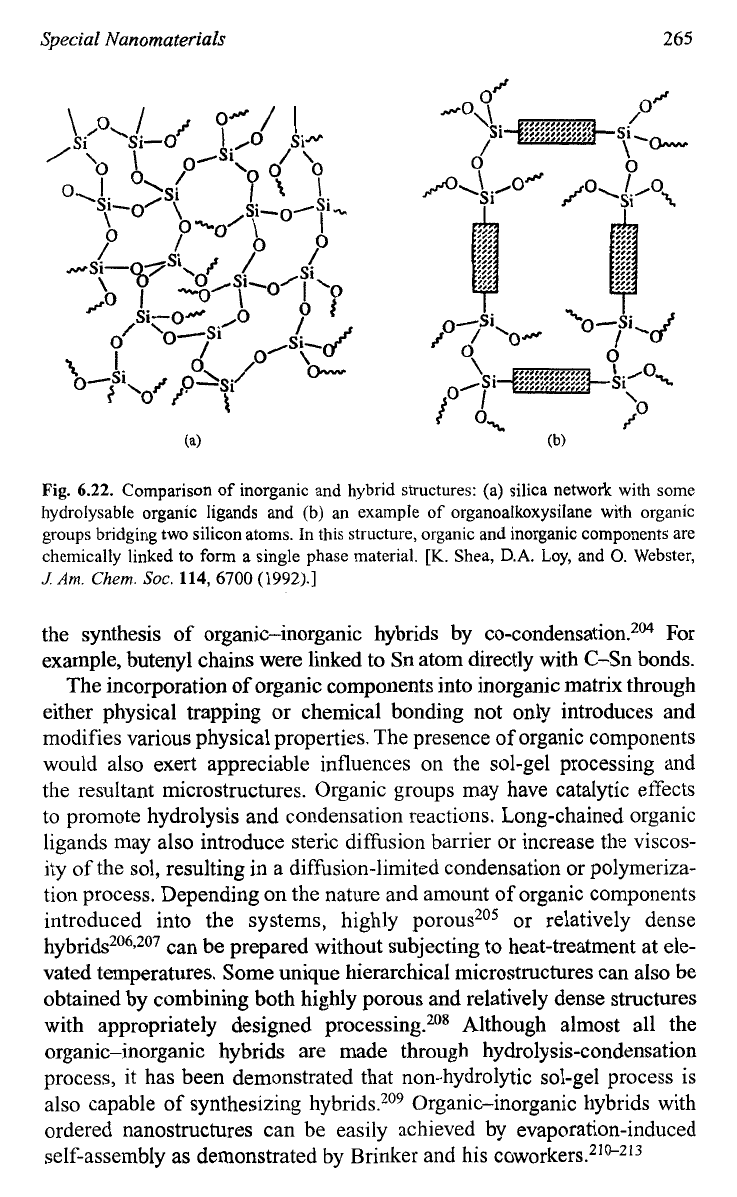
Special
Nanomaterials
265
Fig. 6.22.
Comparison of inorganic and hybrid structures: (a) silica network with some
hydrolysable organic ligands and
(b)
an example
of
organoalkoxysilane with organic
groups bridging two silicon atoms. In this structure, organic and inorganic components are
chemically linked to form a single phase material.
[K.
Shea, D.A. Loy, and
0.
Webster,
J
Am.
Chem.
SOC.
114,6700
(1
992).]
the synthesis
of
organic-inorganic hybrids by co-condensation?@’ For
example, butenyl chains were linked to Sn atom directly with C-Sn bonds.
The incorporation
of
organic components into inorganic matrix through
either physical trapping or chemical bonding not only introduces and
modifies various physical properties. The presence
of
organic components
would also exert appreciable influences on the sol-gel processing and
the resultant microstructures. Organic groups may have catalytic effects
to promote hydrolysis and condensation reactions. Long-chained organic
ligands may also introduce steric diffusion barrier or increase the viscos-
ity of the sol, resulting in a diffusion-limited condensation or polymeriza-
tion process. Depending on the nature and amount
of
organic components
introduced into the systems, highly porouszo5 or relatively dense
hybrid^*'^,*^^
can be prepared without subjecting to heat-treatment at ele-
vated temperatures. Some unique hierarchical microstructures can also be
obtained by combining both highly porous and relatively dense structures
with appropriately designed processing.208 Although almost all the
organic-inorganic hybrids are made through hydrolysis-condensation
process, it has been demonstrated that non-hydrolytic sol-gel process is
also capable
of
synthesizing hybrids.’09 Organic-inorganic hybrids with
ordered nanostructures can be easily achieved by evaporation-induced
self-assembly as demonstrated by Brinker and his co~orkers.~
